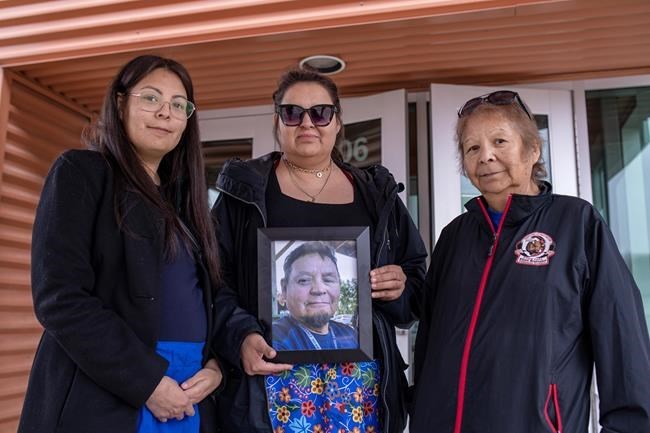MELFORT, Sask. — Myles Sanderson had a list of grievances and was ready to kill anyone who got in his way, a coroner's inquest into a Saskatchewan mass stabbing heard Friday.
Experts testified there was likely a reason the killer chose each of his targets.
"His mission was to attack, injure and murder those who he had a grievance against," said Staff Sgt. Carl Sesely, an RCMP criminal profiler.
"Simple as that."
Sanderson killed 11 people and injured 17 others on James Smith Cree Nation and in the nearby village of Weldon, Sask., northeast of Saskatoon, on Sept. 4, 2022.
The 32-year-old died in police custody a few days later. A second inquest focusing on his death is scheduled for February.
The inquest underway in Melfort, Sask., is to establish the events leading up to the killings, who died, and when and where each person was killed.
Criminal investigative psychologist Matt Logan never met Sanderson and said he cannot make an official diagnosis. He relied on court and prison records, as well as community members.
Sanderson had many psychopathic traits, Logan said. "You've got somebody that's really not looking out for anybody but himself."
Sanderson showed signs he lacked remorse, had a reckless disregard for himself and others, and would explode in unpredictable and violent outbursts, Logan said.
He said the killer likely had anti-social personality disorder and fetal alcohol spectrum disorder. Sanderson was also a high risk to reoffend violently, Logan added.
The inquest has heard Sanderson had a history of violence and incarceration. His common-law partner, Vanessa Burns, testified about 14 years of domestic violence by the father of her five children.
In the days leading up to the killings, Sanderson and his brother, Damien Sanderson, caused chaos in the community.
Myles Sanderson hadn't slept in days and expressed rage toward the Terror Squad, a gang with a presence in Saskatchewan.
Logan said he couldn't discern why Sanderson was so angry at the gang, but "revenge is a strong motivator."
Damien Sanderson’s wife testified Thursday that he feared his brother and called him the devil.
Skye Sanderson said she phoned 911 the day before the stabbings, saying her husband had taken her vehicle without permission. Officers located the vehicle outside a home and spoke with a man inside, but didn't recognize Damien Sanderson. He gave a false name and didn't look like an old photo police had of him.
Skye Sanderson said during this time her husband was also sending her fatalistic text messages about death and missions with his brother.
Sesely said he believes Damien Sanderson was pulled into the situation by his brother. But when Damien Sanderson saw his brother stab someone, the fantasy he had built "crashed and burned," so he stopped the first attack.
Damien Sanderson was the first to be killed, and Sesely said it was because he got in his brother's way.
Myles Sanderson then went through the community armed with a knife, attacking people.
Sesely said many were stabbed because Sanderson believed they were associated with the gang.
Sanderson killed Bonnie Burns and Lydia Gloria Burns, because they were trying to provide medical help to Gregory Burns, who the killer believed was associated with a gang.
Sanderson killed Vanessa Burns’ father, Earl Burns Sr., and Skye Sanderson’s father, Christian Head, because he was angry at both women.
He also injured a woman he thought might call police. Wes Petterson, the only person killed in Weldon, didn't know Sanderson and was likely attacked because he wouldn't give up his vehicle keys, the experts said.
The inquest heard Sanderson went to other homes and left residents unharmed. Sesely said that means Sanderson wasn't trying to "increase the body count," but had intended victims.
Sesely said he believes Sanderson planned to keep killing and his target was Vanessa Burns. He was arrested and died before he could fulfil that goal.
Burns said Friday the testimony about her partner has been difficult but provided some insight into his behaviour. She felt sorry for him, she said.
"But I'm ready to move on with my life."
Logan also discussed the killer's unstable childhood, noting Sanderson was bounced around different homes and suffered physical and emotional abuse.
He was using alcohol by 13 and later used cocaine and methamphetamine.
Logan said it's likely Sanderson felt unwanted and abandoned in his childhood, which would be a trigger for violence as an adult.
Sanderson dropped out of high school and didn't keep a job for long. His lengthy criminal history included 59 convictions as an adult.
He was unlawfully at large at the time of the killings.
Mandy Maier, who works in communications with the RCMP, told the inquest Friday that human error was behind an emergency alert with the wrong image of the killer.
The third dangerous person alert the morning of the attacks included photos it said were of Myles and Damien Sanderson. However, Maier said her unit was notified at about 9.a.m. the photo of Myles Sanderson was of another person with the same name from the same community.
Maier said the photo was immediately removed from the alert website. Another alert with the correct photo was sent out by about 10 a.m.
Keith Brown, the First Nation's lawyer, asked Maier why the community would not be asked for images or confirmation of Sanderson's identity.
"We think about how quickly this incident is unfolding and we use the information that we have at the time," she said.
She said secondary conversations with members of the First Nation could have caused a delay.
This report by The Canadian Press was first published Jan. 19, 2024.
Kelly Geraldine Malone, The Canadian Press

